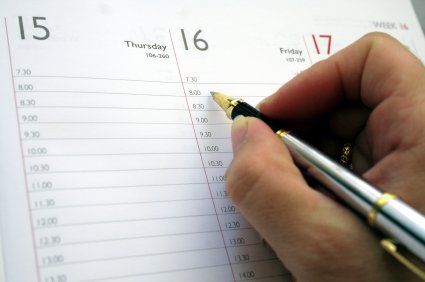The Hunt For The Perfect Planner – Which Calendar Format?

The subject of planners comes up often in my discussions. It seems like everyone is on the hunt for the perfect planner and that hunt is a never ending and overwhelming task for many people. There are thousands of planners on the market with the attractive promise of helping us get our proverbial act together. Each planner is a little bit different in terms of its functionality and aesthetic appeal. With so many options to sift through, how do you choose the planner that’s right for you? Rather than starting the search by comparing planners the overwhelming number of planners, start by thinking about which features will serve you.
Not only do planners help keep track of appointments, they can help manage projects and to-dos. Additional features include tracking goals, habit formation, expenses, exercise and a host of other things. Planning features for your life’s mission, annual resolutions and menus are also available. Visual appeal often figures into the motivation to use a planner as well as the easy of use and portability. What qualifies as the perfect planner depends on how well the offered functionality meets the need of the user, its usability and aesthetics – all very subjective criteria. That being said, let’s look at some common features of paper planners and some bells and whistles that you may want to consider. By the way, I’m focusing on non-academic planners here because the needs of students are different from working adults.
The heart of a planner is its calendar. Most planners provide monthly and yearly views that are useful for high-level planning. For the detail level, you have a choice of a daily view or a weekly view. The former puts the hourly increments of one day per page. Some planner designs spread one day over two pages, but the second page is usually dedicated to features other than hourly increments – such as a task list. Planners with a weekly view spread the entire week over two pages. Weekly views can either be formatted with rows, where each day occupies a row, or with vertical columns, where each day occupies a column. While the row format provides the continuity of seeing the whole week at once, it often does not offer hourly increments; therefore, it works for someone who does not have a lot of appointments during the day. For folks with heavily scheduled days, the vertical format provides a good option. The added benefit of the vertical format is that the patterns for how time is spent are very noticeable due to the hourly increments stretching across the week’s worth of days.
Just in case you’re in a rush, here is a compare and contrast summary of planner calendar features and some examples of each.
Individual Day Displayed On Each Page or Across Two Pages
Good For…
Not So Good For…
Heavily scheduled
Seeing patterns in how time is spent
Recording many tasks and notes for each day
Developing a sense for the amount of time before a deadline
Detailed planning of each day
Emily Ley Daily Simplified Planner
Day Runner Two-Pages-Per-Day Planner
Franklin Covey One-Page-Per-Day Planner
Week Displayed Across Two Pages
Good For…
Not So Good For…
Heavily scheduled (days displayed across vertical columns only)
Heavily scheduled (days displayed in horizontal columns only)
Seeing patterns in how time is spent
Recording a lot of tasks and notes for each day
Developing a sense for the amount of time before a deadline
At-A-Glance Executive Weekly Monthly Planner
Levenger Circa smartPlanner Weekly Agenda Notebook










